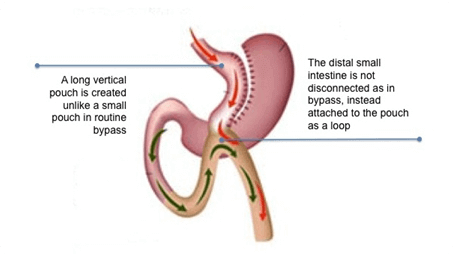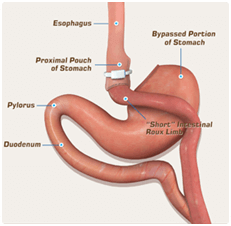Innovations
Innovations
Innovations are constantly being made in the field of Obesity surgery, with good short term success rates. These procedures include Gastric imbrications and Mini Gastric bypass, which gained some popularity in the area of bariatric surgery.
Mini Gastric Bypass

Mini Gastric Bypass seems to be a promising alternative to RY Gastric bypass with less complex technique and comparable short term results. Long term results are needed to recommend MBG as a standard procedure.
The mini gastric bypass procedure was first developed by Dr Robert Rutledge from the USA in 1997, as a modification of the standard Billroth II procedure. A mini gastric bypass creates a long narrow tube of the stomach along its right border (the lesser curvature). A loop of the small gut is brought up and hooked to this tube at about 180 cm from the start of the intestine
The MGB has been suggested as an alternative to the Roux en-Y procedure due to the simplicity of its construction.
Banded sleeve gastrectomy and Banded Gastric bypass
With more studies of weight regain cases being reported around the world, the need for stronger restriction without adding more malabsoprtion led to the development of Banded sleeve Gastrectomy and Banded gastric bypass. These procedures have similar results to regular sleeve Gastrectomy and Gastric bypass, with longer durability because of the band restricting the pouch dilatation thus avoiding an early weight regain. However, long term studies are needed to prove their efficiency.
Banded sleeve gastrectomy

Banded Sleeve Gastrectomy is a surgical procedure that can be performed by minimally invasive surgery. The procedure reduces the size of the stomach to about 10% of its original volume and results in a limited capacity of food intake. Patients feel full after eating a very small amount of food. The volume of the stomach after LCSG is between 80 and 120 ml. A silastic ring is implanted in upper part of the sleeve. This operation does not involve any “rerouting” or reconnecting of the intestine. Also very important is the fact that the operation preserves the pylorus, the muscle that regulates emptying of the stomach. This acts as “natures own functional gastric band” and allows food to remain in the stomach for a while, making the person feel full while the food trickles out. Coupled with the fact that there is no rearrangement of the bowel, it also means dumping and marginal ulcers are not a problem. The normal satiety mechanism is almost always regained by the operation.
Banded Gastric bypass

Banded Roux-en-Y Gastric Bypass (BRYGB) is a surgical procedure that can be performed by a minimally invasive surgical method. The procedure reduces food intake AND reduces the absorption of nutrients from the food. Absorption of nutrients is limited because part of the intestines is bypassed and not used. The volume of the stomach pouch by LBRYGB is between 15 and 25 ml. The junction between the stomach pouch and small bowel is controlled by a silastic ring (GaBP Ring).
UPDATED ON 28/03/2024
Apollo Highlights & Updates
 On World Health Day, Apollo Hospitals has unveiled the 4th edition of the Health of Nation report....
On World Health Day, Apollo Hospitals has unveiled the 4th edition of the Health of Nation report.... Call Us Now
+91 8069991061
Book Health Check-up
Call Us Now
+91 8069991061
Book Health Check-up





